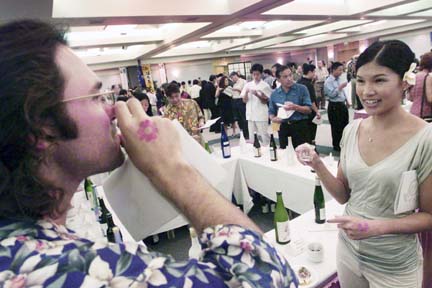

|
Barfly Jason Genegabus |
‘Joy of Sake’
a tasteful delightHONOLULU'S sake drinking public turned out in force last Friday for "The Joy of Sake," the third annual U.S. National Sake Appraisal, held in conjunction with the Japan National Research Institute of Brewing.
According to sake importer and event coordinator Chris Pearce, this year's event was "very successful."
"By far, (we had) the largest attendance in the three years" the appraisal has been held, he said on Monday. "There were 700 people there."
Experts from the United States and Japan were on hand to judge 145 different types of sake, and local residents were invited to take part in sampling some of the fermented rice beverage that's been brewed in Japan for over 1,500 years.
FOR THE uninitiated, sake is produced by mixing milled rice with water and Koji-kin, a type of mold that causes fermentation and gives sake its alcoholic kick. While many people group sake with wine in terms of flavor and aroma, the fact that it's a fermented grain-based beverage means sake is actually closer to beer due to the way it's made. Three different categories of sake were tasted last week: Junmai, Ginjo and Daiginjo.
Junmai is considered the lowest grade of the three, with the rice used in fermentation milled to approximately 70 percent of its original size. Ginjo uses rice grains that have at least 40 percent of the husks ground away; Daiginjo takes it a step further, with at least half of the grains ground away during the milling process. The more "polished" the rice, the more fragrant and sweet the resulting sake will be.
RICHARD WALKER / RWALKER@STARBULLETIN.COM
Tom Barton and Whitney Suyin Lee sample daiginjo sake at the sake festival at the Japanese Cultural Center in Moiliili.
ONE IMPORTANT lesson I learned at "The Joy of Sake" this year -- it doesn't matter what kind of tasting you attend, whether it be wine, beer or sake; one of three types of individuals will end up standing next to, or staggering past you, at some point in the evening.
The first is the person who shows up to graze at the various food stations. Although the point of "The Joy of Sake" is to sample different types of sake from the United States and Japan, pupus from local restaurants including Furusato, Kyo-ya, Musashi and Wasabi Bistro were also served to compliment the alcohol. Some folks spent the entire evening grabbing plate after plate. Can't blame them, though -- the "Pokechos" (poke-covered nachos) from Gyotaku garnered rave reviews, as did Sansei's Pacific Rim Asian tostadas (the Kodama family handed out 500 servings before running out just over an hour into the event).
The second type of taster I noticed was the well-balanced type, someone who already knew a little about sake and made a point of searching out their favorite brands. They would move with pinpoint precision from table to table, only stopping long enough to grab a plate of food. Most folks in this category looked to be professional types, and more than a few were from the ranks of Downtown Honolulu's Aloha Shirt Army.
Finally, there were the hardcore sake drinkers, easily distinguished by their bright red faces and vocal complaints about the lack of air conditioning in the Japanese Cultural Center ballroom where the tasting took place. These people could have cared less that they were getting a chance to try sake previously unavailable outside of Japan, or that an international panel of esteemed judges had chosen a number of brands as superior because of their aroma, taste, balance and overall impression. These guys (and gals) were more excited about the fact that you could serve yourself at this tasting, unlike beer and wine events when someone else pours the alcohol.
ACCORDING TO Pearce, it's the different types of sake drinkers who show up that make the event so successful.
"It's evenly (spread between) men and women," he says. "It's older people and younger people, all racial groups ... (sake) really seems to appeal across a broad spectrum."
And while close to a decade has passed since Honolulu's last sake brewery closed, Pearce remains confident his sake festival will continue to grow. "There's been a really supportive group of sake enthusiasts here for a long time," he said.
"The idea is to raise the overall level (of awareness) and to raise the quality of sake that (the breweries) are making."
See the Columnists section for some past articles.
Barfly appears every Friday in Star-Bulletin Weekend.
E-mail Jason Genegabus at jason@starbulletin.com with suggestions of neighborhood bars to visit.
